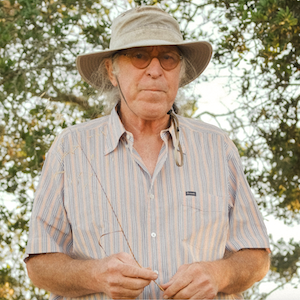
August 3, 2021 – The indefatigable Rhône Ranger, Randall Grahm, is back. This time, in the service of Gallo. To make Rosé, Grenache and Syrah for a project called “The Language of Yes.” It’s like David teaming up with Goliath to throw a lingerie party. As he is very fond of saying, with a wry smile and a sparkle in his eyes, “What could possibly go wrong?”
For the short term, not much, hopefully. After all, this endeavor is surrounded by positivity.
In that spirit, Grahm is determined as ever to bring the splendor of Rhônes to your lips, and hopes you will do so with a smile. Because a smile often means “yes.” Randall Grahm’s latest project is a collaboration with the Gallo Family in an area they have not much dabbled, but is something near and dear to his heart: Rhône varieties. Turns out Gallo has among their many prized vinous possessions a beautiful vineyard called Rancho Real in Edna Valley, and it just happens to have Cinsault, Grenache and Syrah planted therein. Bingo.
“It’s one of the coolest cool climates in California,” says Grahm, of the Santa Maria Valley where he is making the wines. “I was approached by Gallo, and met the family and their executive team. They hadn’t been doing much with Rhône varieties. I was very honored they reached out to me! It turns out I needed a gig. It’s actually turning out to be a stimulating collaboration!”
From whence does this “Language of Yes” stem? As he has so often done for much of his iconic portfolio over the years, Grahm turned to quixotic label designer Chuck House. He thumbed through Provençal dictionaries, looking for just the right word to convey the essence of the project. Grahm explains that Provençal is a dialect of Occitan, also known as Lenga d’Oc. It’s traditionally spoken by people in Catalonia and the south of France, including Provence and the southern Rhône valley.
He says it became apparent that this language of the troubadours skewed towards the positive, and hence, the idea of “yes” seemed a natural fit to describe the optimism and energy of the collaboration.

The first wines of the project, a Rosé made of 65% Tibouren and 35% Cinsault, $30, will be released in mid August, followed by a Grenache and a Syrah, both $40, in October. The wines are being made by Grahm himself at the Gallo facility in Edna Valley.
“It’s very kind of them to allow me to make these wines,” he adds.
For harvest 2021, he hopes to treat Cinsault grapes in the appassimento style, meaning drying them on straw, as they do to make Amarone. “What could go wrong?” he says, with that droll sense of humor poking through the pain of a recent knee surgery. “I am not content to just do something I’ve already done. I want to do something spectacular. Different. I don’t want to make ordinary wine.”
Where Grahm goes, the merely normal, the predictable, the ordinary, will surely not dare tread. He does not keep the kind of sheep that follow Little Bo Peep.
In case you’re wondering, he’s still experimenting with hybridizing grapes to create an uber biome at Popelouchum, his breeding ground for grapes in San Juan Bautista. Although he may be still years off, he feels he’s making progress in at least one area. The collection of Sérine self-crosses that are growing there will produce enough fruit to at least make wine this harvest. “We might get 100 pounds or so from it this year. I’m really excited to see how it turns out.” He admits that he’d love to leverage the might of Gallo to move this crossbreeding experiment forward. Perhaps he can get them to plant some Sérine at Rancho Real.
But back to Rhônes: what is the fundamental attraction? There is an intensity to them that Gallo has been researching, and it has to do with rotundone, a sesquiterpene that occurs in intensely flavored things like black pepper, oregano, basil, geranium and thyme. “The Syrah grape has a huge amount of rotundone,” explains Grahm. “Cabernet Pfeffer has it in spades. Grenache and Mourvèdre also have it to a certain extent. As does Tibouren and Rossese. Also, Teroldego and Refosco.” He’s a big fan.
This peppery chemical compound has been stewing in his conscience for a while. Even though rotundone was officially discovered in Australian Shiraz in 2008, Grahm recalls being in Toulouse years ago and seeing a license plate that read “Rotundone.” One theory behind this compound is that grapes that posses it can more successfully fight off pests like powdery mildew. Whether it’s a self defense mechanism or just a character trait, it’s one he’s eager to magnify, wondering, how does one increase the amount of rotundone in a particular variety? Clicking of hamster wheels. He’s already lobbying to have Tibouren and Rossese planted at Gallo’s Rancho Real. Why not?
Another reason he’s still pining for Rhônes after all these years? “The Pinot Noir craze is going to end one of these days,” he says. “And Grenache will have its day.”
He just needs enough people to say “Yes.”
The only way to purchase these wines is by signing up to be notified of the releases on the website: languageofyeswine.com
About the author
Laura Ness is a longtime wine journalist, columnist and judge who contributes regularly to Edible Monterey Bay, Spirited, WineOh.Tv, Los Gatos Magazine and Wine Industry Network, and a variety of consumer publications. Her passion is telling stories about the intriguing characters who inhabit the fascinating world of wine and food.
- Laura Nesshttps://www.ediblemontereybay.com/author/lness/
- Laura Nesshttps://www.ediblemontereybay.com/author/lness/
- Laura Nesshttps://www.ediblemontereybay.com/author/lness/
- Laura Nesshttps://www.ediblemontereybay.com/author/lness/


